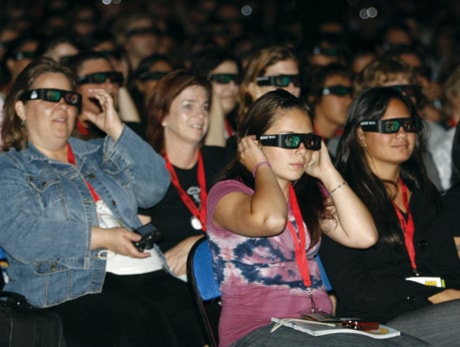MONTREAL — 3-D or not 3-D?
That’s the question many TV lovers are asking now that the three-dimensional experience has come to the small screen.
But one manufacturer’s warning may prompt parents and pregnant women to think twice about allowing space heroes and pirates to jump off the screen into their living rooms.
Samsung Electronics Canada, which recently introduced its 3-D TV in this country, admits the company has only now started to study the long-term effects of watching 3-D television using its “active” glasses which shutter on and off.
“Your left eye shutters 60 times per second and your right eye shutters 60 times per second (with the glasses),” marketing director Robert Gumiela said in an interview.
“We’re not sure how you react to shuttering, but we’re issuing this warning: ’Be very careful. If you start to feel dizzy, stop watching’.”
Samsung issued a 3-D warning several weeks ago and Gumiela says it was done “to make sure we’re doing our due diligence.”
The advisory also urges parents to watch their children for lightheadedness and involuntary movements like eye or muscle twitching, as well as cramps and nausea.
Gumiela was asked why pregnant women, the elderly and people with serious medical conditions were also told to avoid its dizzying effects.
“We don’t have any concrete evidence yet, but the legal teams have just said, ’Let’s cover all bases just in case’,” he said.
Samsung does not recommend watching 3-D “if you are in bad physical condition, need sleep or have been drinking alcohol.”
The highly successful 3-D movie Avatar had people complaining of dizziness and disorientation when they came out of movie theatres.
The lengthy blockbuster is being released this week on DVD and Blu-ray — but only in the standard two-dimensional edition.
What especially concerns some experts is Samsung’s warning that kids and teens may be more likely to experience symptoms than adults.
Dr. Daryan Angle, an optometrist, says 3-D technology “pushes the visual system to the limits — beyond what evolution has designed our eyes for.”
Angle says if eye muscles in young children become fatigued by 3-D viewing “because they haven’t developed strongly enough,” headaches, discomfort or disorientation can ensue.
“Parents have to be aware because their children may not even complain to them that they’re having problems with the movie,” he said in an interview from Kitchener, Ont.
Angle also points out that someone who has a lazy eye — where one eye doesn’t see as well as the other —or is cross-eyed will not be able to enjoy 3-D.
Angle suggests people get a complete eye exam and a series of muscle vision tests to ensure they can watch 3-D TV without experiencing any ill effects.
A training program may even be recommended to get eyes up to speed for 3-D viewing.
Dr. Martin ten Hove, a neuro-ophthalmologist at Hotel Dieu Hospital in Kingston, Ont., says 3-D movies trick the brain and cause an unnecessary strain on eye muscles.
“You’re processing a lot of visual information and your brain has to calculate what makes sense and that’s an environment it’s not used to,” he said in an interview.
A movie like Pirates of the Caribbean or any other film that puts the viewer on a ship in the middle of the sea could create a potential problem — if viewed in 3-D. “Like where you’re on the deck where you’re swaying and rocking . . and then you get up at the end of the movie and walk out, it’s like you get sea legs,” ten Hove said.
“So it’s quite conceivable that kind of film would lead to postural instability and potential falls and seasickness, and all of that.”
But ten Hove said it’s too early to know if 3-D TV was launched prematurely.
“I would be really hesitant to suggest or think that there is a long-term significant impact of this technology, but I think the short-term impact is concerning enough,” ten Hove added.
Gumiela says there’s been a good response in Canada to the arrival of 3-D TV. “Our biggest problem has been ensuring adequate supply to all the different stores,” he added.
Gumiela says Samsung will soon be marketing its least expensive 3-D TV — a 46-inch LCD version will which cost $1,899.
That may not include the original “active” 3-D glasses which run at $249 a pair or the high-level Blu-ray player which sells for $399.
